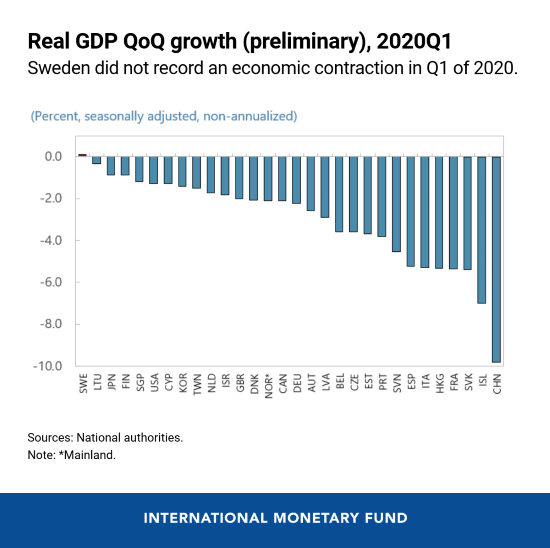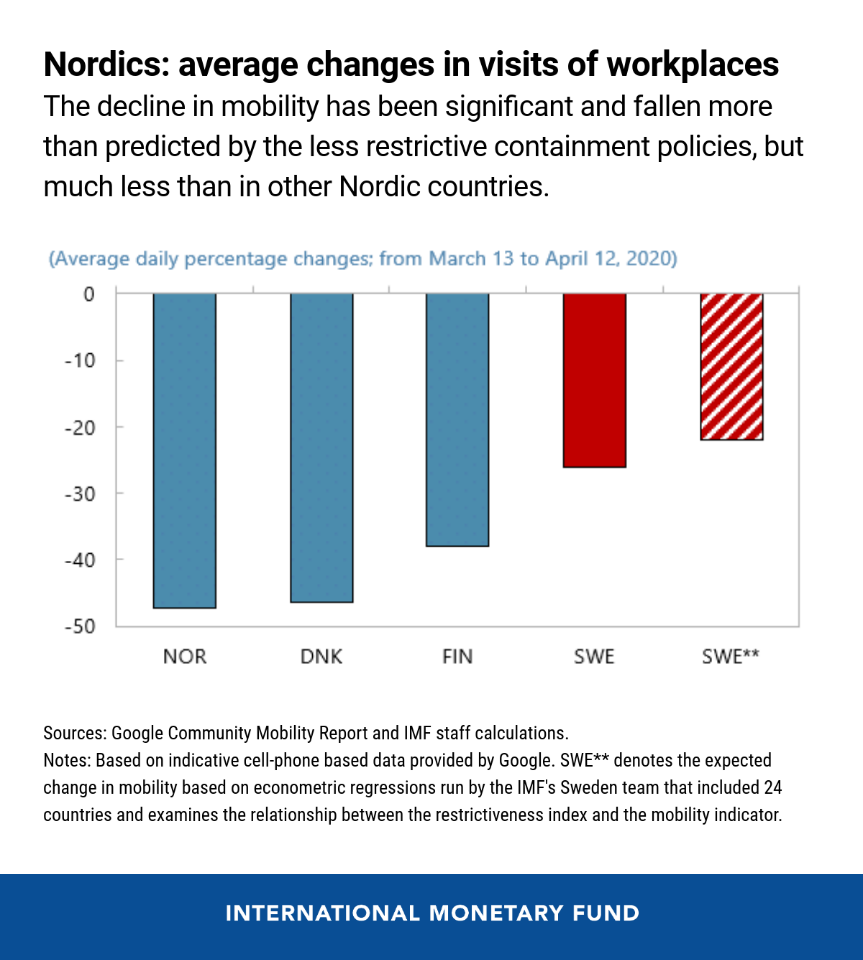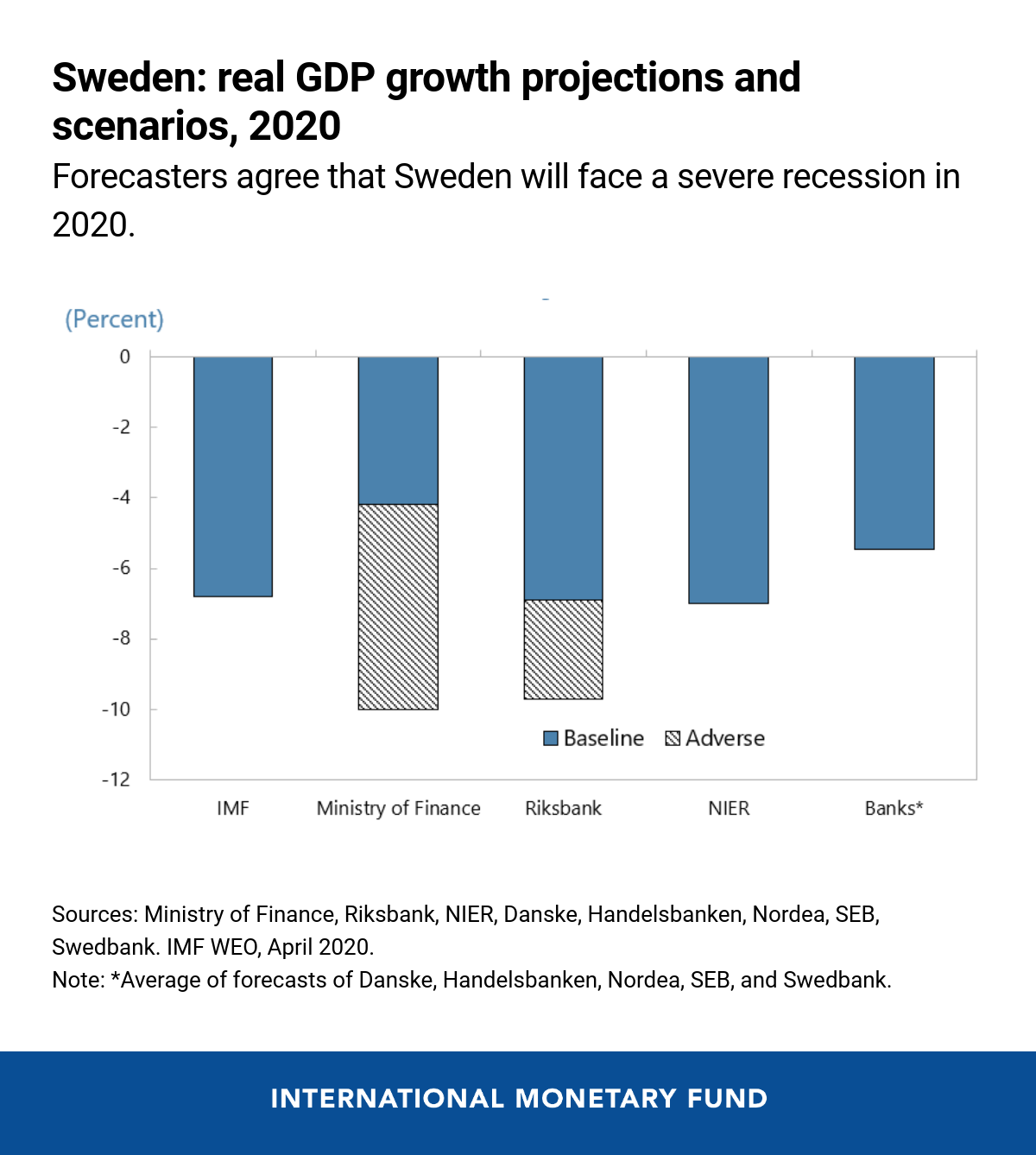
A street in Stockholm, Sweden. Restaurants remained open in Sweden subject to some restrictions (photo: Peter Johansson/Avalon.red/Newscom)
Sweden: Will COVID-19 Economics be Different?
June 4, 2020
Sweden’s less restrictive containment strategy may have resulted in a milder economic contraction at the onset of the crisis, but uncertainty remains about its implications for the rest of the year. Other factors, including falling external demand, will heavily weigh on growth. Concerns have also been raised about the country’s death rate which, although lower than in Europe’s worst-affected countries, is a multiple of its Nordic neighbors.
In this article written for IMF Country Focus, the IMF's Sweden team* explains that the merits of Sweden’s strategy to contain COVID-19—which is based more on recommendations and social responsibility than legal obligations—are increasingly attracting attention, both from a health and an economic perspective.

The rationale for choosing this less restrictive approach was the view that the pandemic would last a long time.
Therefore, measures need to be socially and economically sustainable, while also keeping infection rates at a level that the Swedish health system can handle. The latter objective seems to have been achieved. However, the death toll so far has been relatively high.
Deaths have been concentrated along demographic, geographic, and socioeconomic lines: 50 percent of deaths occurred in elderly care facilities, and the 70+ age group accounted for almost 90 percent of all deaths.
In addition, greater Stockholm accounts for 50 percent of the deaths, with areas that have a higher share of persons that are foreign-born or have foreign-born parents being more heavily affected. This highlights the challenge of protecting the vulnerable in the absence of a more stringent lockdown, even in a country with favorable socio-demographic characteristics, including a very high share of single-person households. The outcome could have been worse in countries with different demographics, resources, or history of abiding by social contracts.

Sweden’s approach may have moderated the economic impact at the onset of the crisis, as indicated by the small increase in GDP for the first quarter of 2020 contrary to other advanced economies. Consumption declined less than in other countries, and exports temporarily increased.
There was also a significant difference in people moving around, based on data from cell phones: The decline in mobility in Sweden was less than in other Nordic countries. However, visits to workplaces appear to have fallen more than predicted by the less restrictive containment policies.
This suggests that voluntary changes in behavior can play an important role, irrespective of regulations. However, while mobility does reflect economic activity to some degree, there are various other factors that affect the latter.
Domestic containment policies have a greater bearing on domestic demand, and particularly on non-tradeable—such as services—rather than tradeable sectors. The purchasing managers index (PMI) and other indicators that capture the perspectives on the economic outlook at the sectoral level appear to confirm that. The decline in service activity in Sweden between February and April, although significant, was much less than among European peers.
Swedish manufacturing, which is export-oriented, has also been hit hard: the fall in the manufacturing PMI in Sweden that started in March was in line with what other European countries are experiencing. This reflects a drop in external demand as well as supply chain disruptions, which are not determined by the country’s own containment policy.
Together, these factors, and the relatively large fall in employment in recent weeks suggest the containment strategy may affect quarterly GDP growth rather than the outcome for the year as a whole. Most forecasters agree that Sweden will face a severe recession this year, but it is too early to say whether this strategy will prolong the recession or aid the recovery.
Any final verdict will also depend on whether, as a by-product of its approach, Sweden is closer to achieving herd immunity, thereby increasing its resilience in the event of another wave of infection. Medical knowledge about Covid-19 is still accumulating, and recent tests indicate that immunity gains have been lower than initially projected.
Irrespective of the containment strategy, swift decisive macroeconomic policy action remains critical to avert more dire economic outcomes. Sweden’s policy response to combat the economic impact of the pandemic has been prompt, large, and well-designed. This highlights the importance of having built up ample fiscal space, and of preserving the operational independence of the central bank (Riksbank), enabling it to quickly deploy a broad menu of instruments.
* IMF mission team members: Jana Bricco, Florian Misch, Khaled Sakr, and Alexandra Solovyeva.










